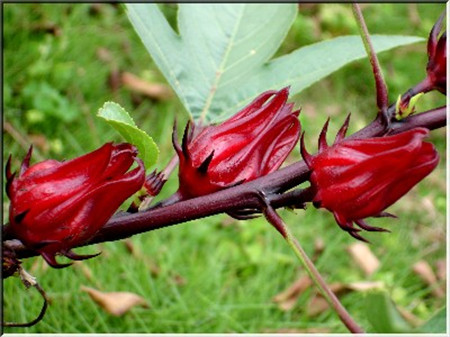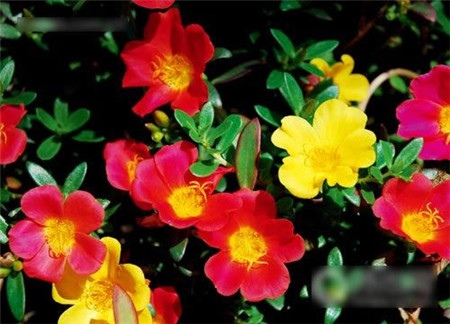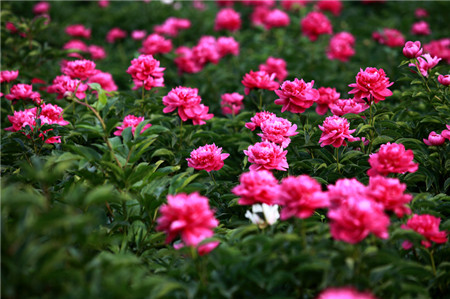The growing environment of Luoshenhua
Luoshenhua (Roselle) is a tropical and subtropical short-day crop, which likes light, temperature and avoid early frost. it grows best under the condition of 25 ~ 30 degrees Celsius. The rose eggplant is sown from March to May and harvested from September to November. The whole growth period is 160-200 days, and the effective accumulated temperature is about 500-550 degrees Celsius. There are certain requirements for temperature, humidity, light, soil conditions and so on.
The soil of the growing environment of Luoshenhua (Roselle)
Luoshenhua (Roselle) belongs to straight root system, with well-developed lateral roots, deep roots, drought tolerance and wide adaptability. It grows well in sandy loam and ph6-8 soil with medium or lower fertilizer; the fertile land has many branches, sepals are thick, and the yield is high, but it is easy to grow and lodge and affect the yield; if the soil is too thin and sticky, it is easy to produce physiological diseases such as albino seedlings. During the growing period, poor drainage is prone to root rot, root rot and death. In case of overcast and rain during harvest, the calyx is easy to mildew, which directly affects the yield and quality.
Luoshenhua (Roselle) has wide soil adaptability and can be cultivated in plain, hilly and mountainous areas. red-yellow soil, blue-purple mud, gravel sand and clayey soil can be planted successfully, and semi-mature yellow soil is better. Rose eggplant can be interplanted with dwarf crops such as peanuts, legumes or unproductive orchards. With the same piece of land-like continuous cropping for several years, it is better to continue to be susceptible to disease.
The temperature of the growing environment of Luoshenhua (Roselle)
With the increase of temperature, the germination time of seeds shortened and the germination rate increased. The optimum temperature for seed germination is 20-25 degrees Celsius, the average daily temperature is 16 degrees Celsius, vegetative growth requires more than 22 degrees Celsius, and growth tends to stop at 10 degrees Celsius. The vegetative growth peak of plant height and stem diameter was from July to August, when the high temperature and humidity reached the suitable conditions for the growth of rose eggplant.
Humidity
In the growing period, stagnant water, high fertilizer soil, susceptible to bacterial wilt, white silk disease, the incidence rate is as high as more than 40%, arid mountains, or even newly opened barren mountain planting, rarely occur.
The Light of the growing Environment of Luoshen Flower (Roselle)
Luoshenhua (Roselle) is a strong light plant, which is planted in the shade of dense forest and the planting density is 1 × 0.5m. Under the condition of high plant height, thin stem, few branches, low yield and sunshine hours, the budding and flowering period is obviously affected by sunshine hours.

The Culture method of Luoshenhua growth habits of Luoshenhua
Luoshenhua believe many friends have heard that Luoshenhua is full of treasures, the seeds can extract oil, the medicinal value is very high, but also edible, and the stem can be used as beverage and fuel. Then how to raise Luoshenhua? What are the growth habits? Let's take a look next.
I. the culture method of Luoshenhua
1. Soil requirements: Luoshenhua is a plant that is afraid of waterlogging and drought, so it is appropriate to choose sandy loam with sunny, deep soil layer and good drainage. 1000-1500 kg of farm manure or 100kg of organic compound fertilizer were applied per mu.
2, planting density: according to the soil fertility, plant row spacing: (0.6 × 0.8) cm, sowing 1300 trees per mu is appropriate. One kilogram of Luoshenhua seeds can plant more than 2 mu.
3. Sowing time: soaking seeds for 12 hours before sowing, sowing seeds from mid-late April to early May, 4 grains per litter; transplanting seedlings when the height of each seedling is 15 cm.
4. Water and fertilizer management: Luoshenhua does not need large water and fertilizer, but the land with poor soil fertility and seedlings with poor growth should be properly fertilized with 20 kg of compound fertilizer and 8 kg of urea per mu to raise seedlings; 30 kg of compound fertilizer and 20 kg of potassium sulfate per mu before flowering to meet the needs of flowering.
5. Seedling stage treatment: when the seedlings grow to 10 meters and 15 centimeters, there will be weak seedlings and diseased seedlings, leaving only one strong seedling in each litter, and the rest should be set aside to fill the gap. The seedlings should not be too late, otherwise the growth of the seedlings should be affected. When the seedlings are 80 centimeters high, they should be tapped to make the branches strong and flowers have many calyx fertilizers.
6. Intertillage weeding: the plant height is 30 cm, combined with topdressing and soil cultivation, intertillage is carried out for 2 or 3 times at the right time. Weeds should be pulled out artificially in summer, and attention should be paid to digging ditches and draining waterlogging in the rainy season to prevent and control the occurrence of dead seedlings and root rot.
7. Pest control: Luoshenhua is relatively resistant to insect pests, and there are generally few diseases and insect pests. For insurance, seedlings can emerge 5-7 days after sowing, and 2.5% cyhalothrin 50ml / mu spray is used to control pests. Prevention and treatment of root and neck rot: use 5% Baodining 5 g, 2% Chunreomycin 30 ml for 15 kg of water for the second time. Spraying pesticides must be carried out before flowering, and it is strictly forbidden to spray pesticides during flowering, so as not to leave poison in the calyx and affect the quantity of products.
Second, the growth habits of Luoshenhua.
Luoshenhua is distributed in Taiwan, Fujian, Guangdong, Guangxi, Yunnan and other provinces and regions, tropical and subtropical regions. Rose eggplant is a tropical and subtropical short-day crop, which likes light and temperature and avoids early frost. It grows best under the condition of 25 ℃ ~ 30 ℃. Generally, rose eggplant is sown from March to May and harvested from September to November. The whole growth period is 160-200 days, and the effective accumulated temperature is about 500-550 ℃. There are certain requirements for temperature, humidity, light, soil conditions and so on.
The above is the breeding method of Luoshenhua and the introduction of the growth habits of Luoshenhua. Luoshenhua is not only of high ornamental value, but also of edible, medicinal and economic value.
A nickname for Luoshenhua.
Luoshenhua, also known as rose eggplant, Luoshenkui, Luoshenguo, mountain eggplant, Luoji sunflower, red plum, red plum fruit.
The growth habit of Luoshenhua
Luoshenhua likes the light, and likes the relatively warm environment, generally between 25 ℃-30 ℃, the growth will be better. Luoshenhua is more drought-tolerant, in the life of breeding Luoshenhua should pay attention to avoid stagnant water, so as to avoid diseases and insect pests.
In addition, the adaptability of Luoshenhua is relatively strong, and the life of breeding can choose sandy soil or clayey soil to cultivate.
The floral language of Luo Shenhua
The flower language of Luo Shenhua is the feeling of love.
- Prev

Planting techniques of sunflower
Sunflowers are very easy to survive, so the planting technique of sunflowers is very simple. Although simple, but the sunflower planting technology in the operation process should pay attention to the following points. Sunflower seeds are very small, about 8400 per gram, often sown on seedling trays and slightly covered with fine vermiculite.
- Next

Matters needing attention in planting Paeonia lactiflora
Paeonia lactiflora is native to northern China and belongs to perennial root flowers. now there are more than a thousand varieties in the world, and there are about 180 species in China. Paeonia lactiflora has strong adaptability and cold tolerance, and can survive the winter in open fields in the north of China. At present, wild species are distributed in Qinling Mountains, Dabie Mountains and other places, but three points should be paid attention to in planting peony flowers: -, soil drainage should be good.
Related
- Fuxing push coffee new agricultural production and marketing class: lack of small-scale processing plants
- Jujube rice field leisure farm deep ploughing Yilan for five years to create a space for organic food and play
- Nongyu Farm-A trial of organic papaya for brave women with advanced technology
- Four points for attention in the prevention and control of diseases and insect pests of edible fungi
- How to add nutrient solution to Edible Fungi
- Is there any good way to control edible fungus mites?
- Open Inoculation Technology of Edible Fungi
- Is there any clever way to use fertilizer for edible fungus in winter?
- What agents are used to kill the pathogens of edible fungi in the mushroom shed?
- Rapid drying of Edible Fungi

